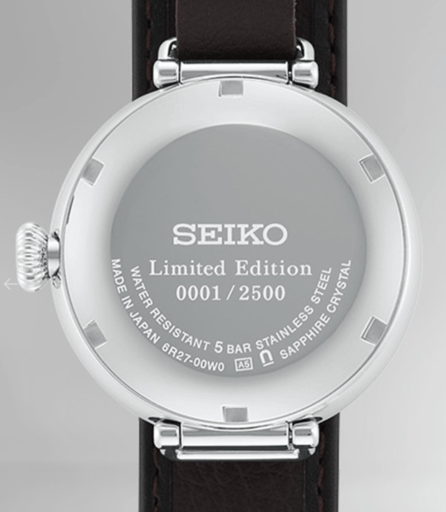
Back when I collected pinball machines, Medieval Madness was the apple of my eye. I was about to pull the trigger when Planetary Pinball produced Medieval Madness Remake. Same exact game, only modern. That’s the one I bought. Now have a look at the new Seiko Laurel, a 2500-piece limited edition remake of Seiko’s first wrist watch. Only not . . .
The original Seiko Laurel was certainly a milestone. theseikoguy.com has excellent photographs and a potted history . . .

At a time when pocket watches dominated the scene, Kintaro Hattori, the founder of Seiko, realized that the wind was changing and decided to start the production of wristwatches.
The Laurel was introduced around 1913 and is considered the first Japanese wristwatch, although its movement was originally designed for small pocket watches. With the tools of the time, manufacturing and assembling components much smaller than usual was not easy.
The production of the Laurel was a major challenge for Seiko, which allowed the Japanese company to develop new techniques and sophisticated machinery. It is said that, at least at the beginning, they were only able to produce a few dozen Laurels per day.
Despite hypebeast.com’s contention that the new watch “faithfully recreated” the antique timepiece and monochrome-watches.com’s assessment that it’s “surprisingly faithful” to the original, the differences between old and new are legion.
Shockingly, Seiko “re-imagined” the original’s small seconds subdial as a date indicator and added a full-size second hand. And a power reserve indicator. And an embossed triangle on its deerskin strap. And watch face markings aplenty (Seiko Presage Automatic and text along the bottom of the dial).

The new watch has swing lugs; early Laurels’ were fixed. The old Laurel’s case was silver, 18k gold or gold and copper combined. The new Laurel’s is stainless steel. The old watch was 34mm vs. the new gen’s 37.5mm. And where’s the original’s red 12? Gone.
Also missing: the discreet markings on the rear, replaced with boasts of the new watch’s modern capabilities and a proud declaration of its Japanese origin. The biggest difference is, of course, the movement.

Like IWC’s Portugieser, the original Laurel was powered by a modified pocket watch movement. No surprise there: Seiko’s first effort debuted in 1913, when men’s wrist watches were just becoming a thing (de-feminized by troops returning from World War I). Anti-shock? Water resistant? Hacking seconds? Self-winding? Nope. Accuracy? Pretty good, not bad, you can’t complain – relatively speaking.
The new Laurel offers all of the above and runs off Seiko’s thoroughly modern automatic caliber 6R27 movement, delivering 45 hours of power reserve and +25 to -15 seconds per day accuracy. Debuting in 2013, the 6R15 was Seiko’s answer to the Swiss workhorse ETA 2824. Seiko fits the movement into both its Prospex and Presage lines, into which the new Laurel slots.
Most importantly, at least for sales, the new watch mirrors the original’s enamel dial, using the same typeface as its forebearer. To the casual observer, the new Laurel is an old watch. To the average enthusiast, what’s old is new only “better.”
Only it isn’t. Not only does the new Laurel lack the simplicity of the first Seiko, it turns its back on its mechanical past (like the new Portugiesers). It is, in a word, a fake.

While it’s now standard practice for a watchmaker to celebrate an important birthday – 110 years of Seiko production in this case – with an “homage” to its past, Seiko’s decision to mess with the aesthetic and mechanical formula that launched their brand shows just how far the company strayed from its origins.
What they should have done: recreated the Laurel using modern materials and techniques. That’s what Planetary Pinball Supply did with Medieval Madness – ruining the “holy sh*t you got one of those?” value of the original, but pleasing me no end.
You can pick up an original Seiko Laurel for around $2k (including the cost of servicing and fixing issues). That’s the same price as the newbie. Which one would you buy?

What is Seiko’s obsession with power reserve indicators?
And yes. If you’re going to hew to a heritage design so closely, be sparing with the “updates” for they will, if nothing else, age badly.